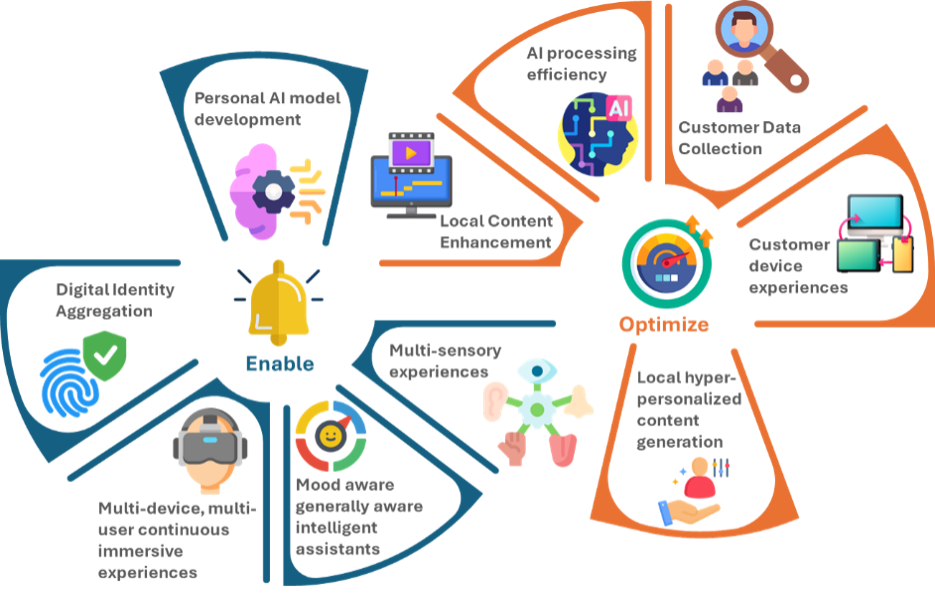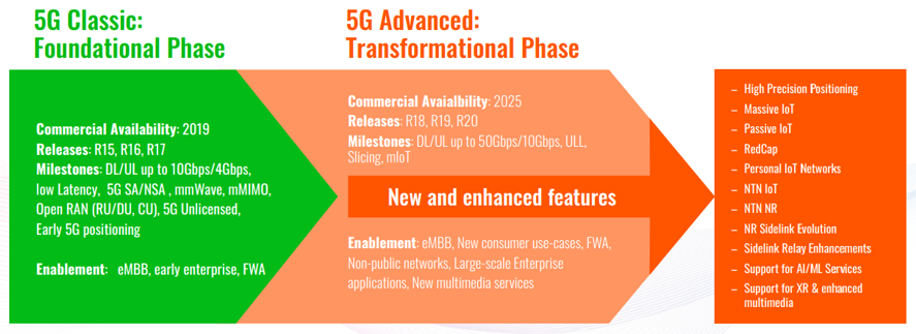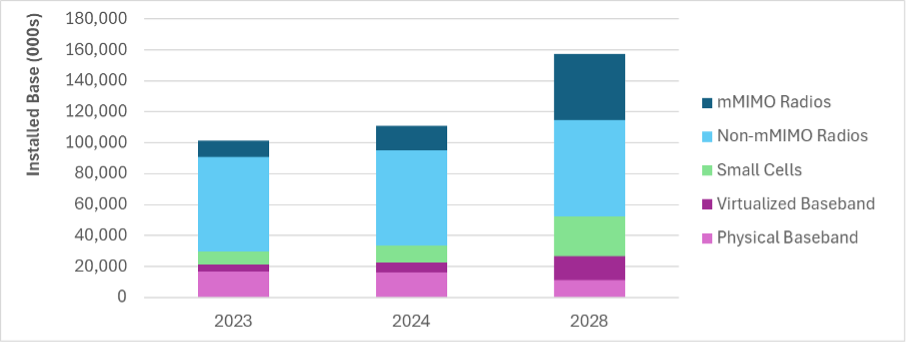Artificial Intelligence (AI) is already showing it is having a significant impact on the world’s economy, our online experiences and sourcing information — both visual and textural. In turn, AI is impacting the mobile cellular economy. AI is a key catalyst for the growth in cellular data traffic, marking the shift from the Mobile Data Era to the Mobile AI Era — where AI powers intelligent, personalized and content-rich experiences that are fundamentally underpinned by XML data streams and video and audio codecs.
As AI-powered applications push cellular data traffic to new heights, next-generation hardware is evolving to keep pace. One of the most promising innovations in this space is the Extremely Large Aperture Array (ELAA) antenna technology, which promises significant gains in both coverage and user experience and are poised to become foundational in 5G-Advanced and future 6G architectures.
Figure1. How Do AI-Enabled Devices Create Value?

This shift will be driven by the evolution of mobile, wearable and robotic AI agents. From voice-based personal assistants to Augmented Reality (AR)-enabled wearables and embodied robots handling physical tasks, these agents are expanding how users interact with both the digital and physical worlds.
AI enablers like Natural Language Processing (NLP), computer vision and speech recognition are accelerating content creation and innovation — boosting demand on telco networks. In the near term (i.e., the next 2 years), they enable real-time tools; over the next 4 to 6 years, AI enables virtual production and hyper-personalization; and in 8 years from now, AI is anticipated to be fully integrated into autonomous workflows. From ABI Research’s own research, AI investment is projected to grow from US$ 100 billion in 2023 to US$ 390 billion by 2030, Generative Artificial Intelligence (gen AI) could be potentially responsible for 45% of that 2030 total.
5G-Advanced reinforces the cellular network
It has been approximately 7 years since the first 5G network was launched. In that time, over 300 operators have deployed public 5G services, and global subscriptions are projected to reach 4.2 billion by 2029. The latest iteration of 5G, 5G-Advanced, is now gaining traction, with more than 60 operators launching services. As the next evolution of 5G, it delivers ultra-low latency (under 4 Milliseconds (ms), enhanced reliability — critical for autonomous vehicles and industrial automation, as well as enabling download/upload speeds of 10:1 Gigabits per Second (Gbps).
Figure 2. 5G-Advanced Supports a Rich Portfolio of Features

The additional features that 5G-Advanced brings online will also leverage AI applications and embedded services. 5G-Advanced introduces high-precision positioning, massive Internet of Things (IoT), enhanced Reduced Capability (eRedCap), Non-Terrestrial Networks (NTNs) IoT/New Radio (NR), enhanced Extended Reality (XR) and Sidelink upgrades. This will unlock new enterprise and consumer applications.
This is also expected to drive cellular data traffic to 3.4 Zettabytes (ZB) by 2028 from 1.5 ZB today. All that data traffic needs to be transmitted wirelessly from the handset, tablet, laptop and IoT module to the nearest base station, which means the Communications Service Providers (CSPs) will need to upgrade their base station and small cell antennas.
5G-Advanced will require the potential of TDD spectrum
Frequency Division Duplex (FDD) spectrum, with its separate uplink and downlink channels, has been very much the workhorse for the mobile telcos, where it is often used in lower frequency bands (900 MHz, 1,800 MHz, 2,100 MHz and 2,600 MHz) for wider area coverage and better indoor penetration.
However, as mobile telcos scramble for more spectrum to carry more traffic, Time Division Duplex (TDD) spectrum has been brought online. TDD, with its single frequency band for both uplink and downlink, has allowed for wider channels, therefore helping to boost data throughput. TDD is often deployed in the mid-band (2,300 MHz), 2,600 MHz, 3,500 MHz, 4,900 MHz) and high-band Millimeter Wave (such as n257, n258, n261) spectrum.
Base station antenna innovation is not slowing
Base station antenna designs have evolved rapidly over the past 15 years. 4T4R was a typical passive antenna configuration in the 4G era, but as we have moved into the 5G era, antenna design has had to up its game. 8T8R is increasingly being requested by mobile telcos and they are also insisting that antenna vendors demonstrate their reduced power consumption, their ease of deployment and future upgradability/modularity to minimize not just their carbon footprint, but also allow the mobile operator to continuously fine-tune the performance of the Radio Access network (RAN).
An antenna information sensor unit can help ensure that the antenna is fully optimized and orientated in its local environment. Huawei’s innovations include the reduction in the number of electronics boards within the antenna, the utilization of phase change heat dissipation technology that uses unidirectional fluid circulation to improve heat dissipation, and the use of artificial diamond substrates in the power amplifier to also dissipate heat and “meta” materials that allow the selective transmission and/or the manipulation of Radio Frequency (RF) signals.
ELAA offers significant potential for CSPs
Active antennas, especially massive Multiple Input, Multiple Output (mMIMO) antennas, have been able to boost capacity and coverage for mobile telcos in urban and Central Business District (CBD) areas. 32T32R has been a popular configuration, but we are seeing 64T64R deployments, although those solutions are just the start of the mMIMO innovation wave. Antenna vendors such as Huawei have been upgrading antenna designs to maximize data throughput.
Some of the very latest innovations in base station antenna design can be found in Extremely Large Aperture Array (ELAA) antennas. The number of Antenna Elements (AEs) in ELAAs have ramped up from 192 to 384 AEs, which can potentially boost coverage by +3 Decibels (dB) and lead to a user experience boost of ~30%.
However, Huawei has announced a High-frequency Active Antenna Unit (HAAU) that has 1,024 to 2,048 AEs per ELAA. ELAA antennas are likely to be essential RAN technology in 5G-Advanced, and even 6G network architecture. In an ELAA architecture, the network can adjust the phase of each antenna’s signal and thereby allow for the superposition of RF transmission at the end user’s location, resulting in a substantial data throughput boost.
Mobile data traffic is not what it used to be
Historically, mobile data traffic was skewed toward the download. This reflected the fact that until the early 2020s, most mobile devices were largely (download) consumers of data — website, Facebook and Instagram pages, as well as YouTube videos, Spotify audio, etc. With the rise of Microsoft Teams, Zoom calls and personal broadcasting, the ratio of data traffic being uploaded has increased from 18:1 to 4:1. With TDD and asymmetric MIMO, mobile telcos can decouple the downlink from the uplink, and dynamically reassign the spectrum resource to match their end-user usage habits. The ratio of traffic that is on the upload is likely to continue to equalize — and not just in developed markets, but also in emerging markets.
Holographic MIMO reconstructs cellular networks and evolves to cell-free networks
Upgraded 5G networks using multiple frequencies face a major challenge… coordinating thousands of antennas across a swathe of cell towers becomes substantially harder. Tasks such as directing the RF signals (beam management) and syncing connection data now require significant coordination. This is where holographic MIMO steps up, effectively enabling the cluster of antennas to work like a “hologram.” Instead of updating connection info on a sequential basis (like passing notes in class), all the antennas can share updates simultaneously, like a group chat.
This “parallel teamwork” helps networks handle massive data flows more efficiently, acting like a Three-Dimensional (3D) puzzle solver where every piece connects perfectly. This density of ELAA AEs helps to balance “high” and “low” spectrum band coverage. The network effectively becomes a “single network,” rather than a multitude of cells, which is what previous cellular networks were.
Summary of insights and conclusions
Mobile telcos have done stunningly well with cellular. In just 30 years, it has become a US$1.5 trillion service revenue industry, and that excludes device and infrastructure revenue. Clearly, a whole host of technologies is needed to deliver the “cellular experience.” While the full impact of AI has yet to be fulfilled, it is unambiguous that AI will drive up data traffic, which then needs to be handled by the cellular network. Base station antenna design and development will need to handle the strain.
As Figure 3 demonstrates, the most significant growth in RAN elements will stem from deploying mMIMO antennas. Indeed, there may be further uplift to the forecast as the full impact of ELAA antennas has yet to be factored in. There are clearly challenges regarding ELAA antennas, most notably regarding their power consumption profile, but new component technologies are starting to reduce the energy demands.
Figure 3. mMIMO Elements Will Come to Dominate the RAN Landscape


